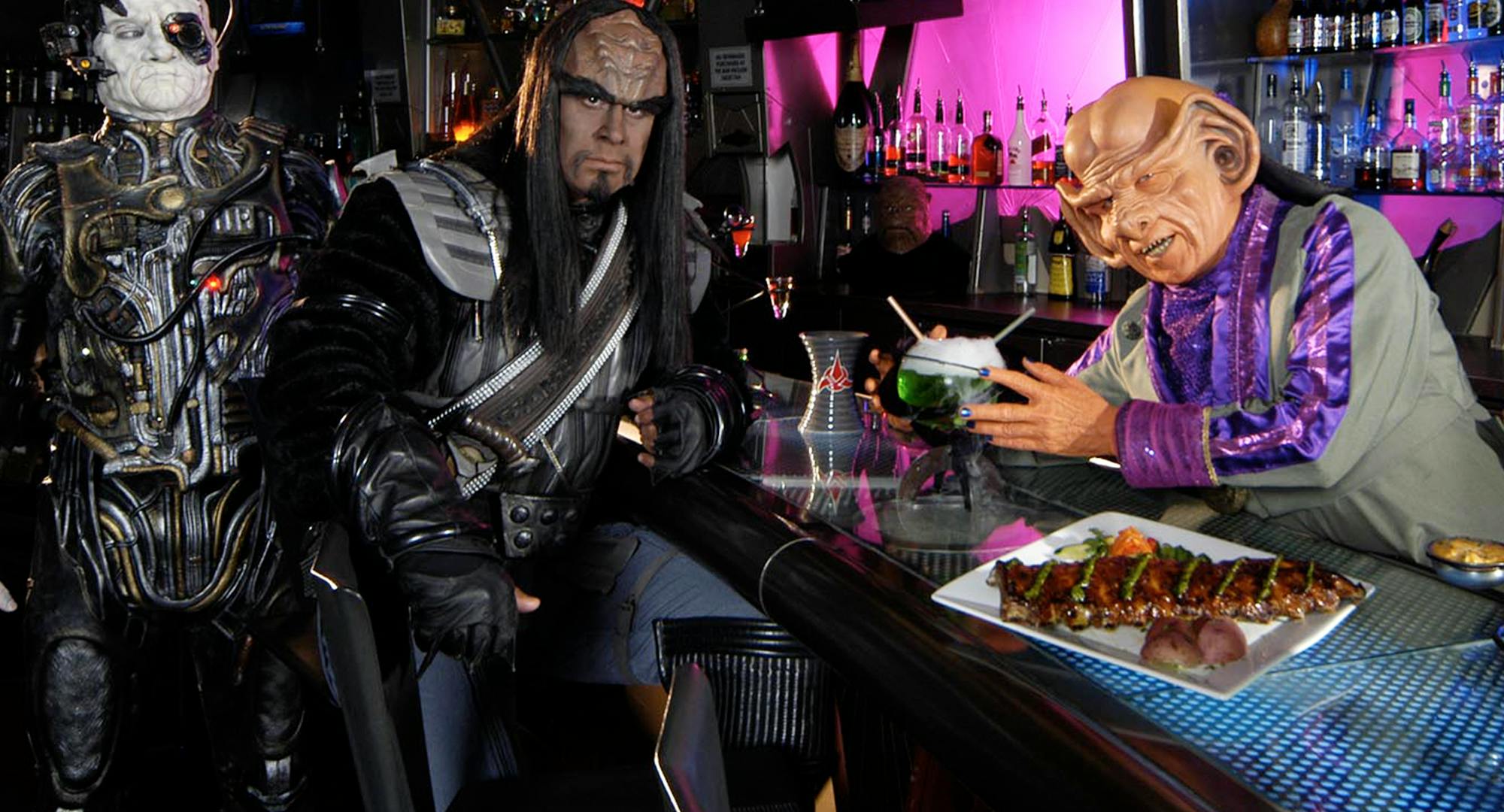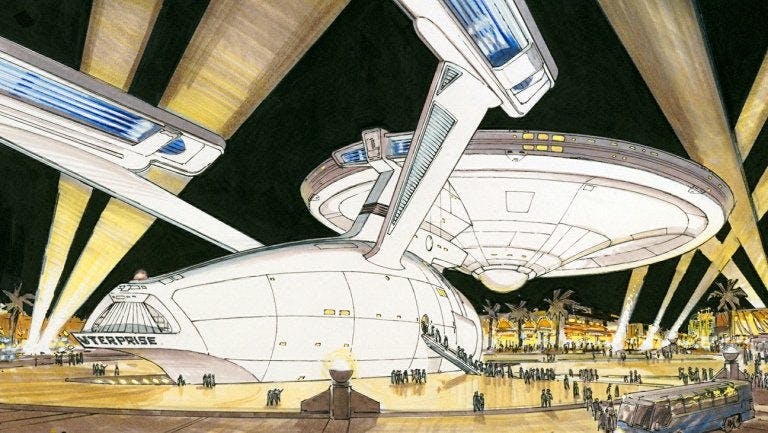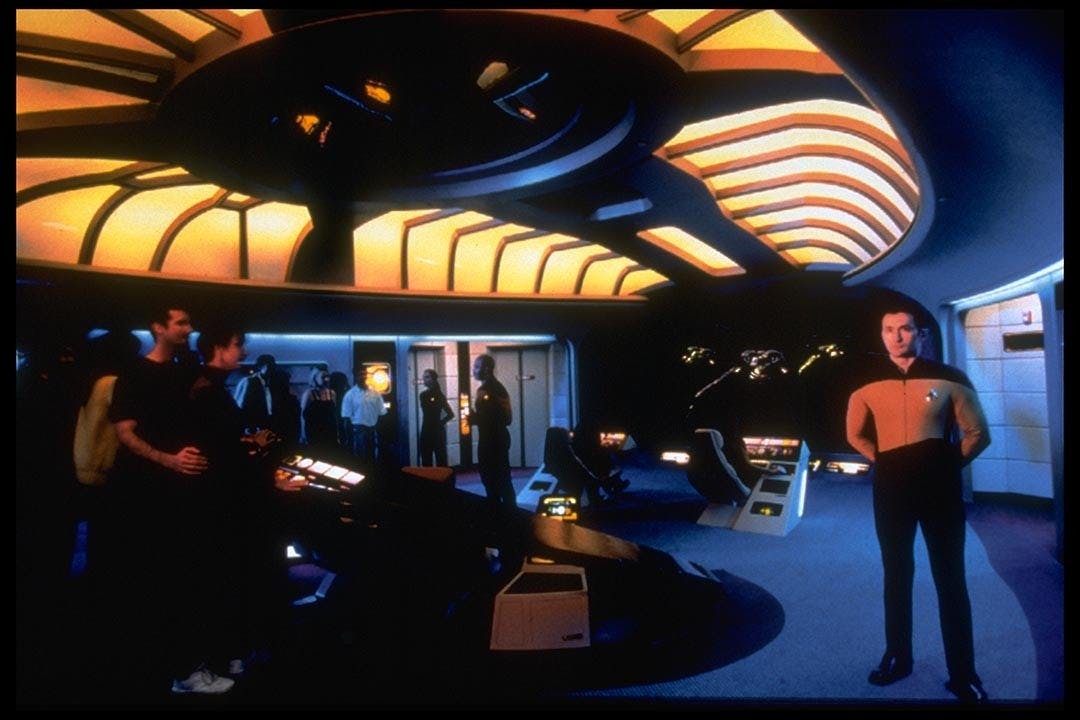Published May 19, 2020
How Star Trek Came to Las Vegas
Unsurprisingly, it was a huge gamble.

StarTrek.com
CW: After the closure of Star Trek: The Experience in 2008, Gary Goddard was accused of sexual misconduct by 8 actors in 2017.
In early 1998, the “coolest thing to happen to Star Trek since the Enterprise-E” (at least according to the Desert News) opened in Las Vegas, Nevada at the Las Vegas Hilton. Star Trek: The Experience was an expansive, 65,000-square foot space that included a walk-through exhibit of props and costumes, a simulator thrill ride, and an immersive shopping and dining area populated by aliens and other intergalactic visitors. It embraced the various series’ optimistic outlook on the future, combining, at one point, storylines from The Next Generation, Voyager, and Deep Space Nine eras, and offered a unique experience that was just as thrilling for die-hard fans as it was for average tourists less steeped in the lore. While Star Trek: The Experience closed its doors in 2008, it remains beloved (and deeply missed) by those that visited and the staff that populated the attraction. And, true to form, the tale of how Star Trek landed in Las Vegas offers the kind of twists and turns that you could only expect from your favorite space saga.
STLV 2019: That's a Wrap
First Contact
Initially, Star Trek was going to come to Las Vegas in a very different form. In the early 1990s a consortium of businesses wanted to inject fresh life into the ailing downtown area, which had been all but overcome by the new hotels and resorts on the strip. A call was put out for submissions. “Their requirements were, they wanted a project of such magnitude that it would draw back the business from the strip. That’s an almost impossible task,” said Gary Goddard, a former Imagineer whose company Landmark Entertainment entered the competition. Their pitch? “What if we built the Starship Enterprise, full-size?”

StarTrek.com
Since some of the stipulations of the project were that it couldn’t be a hotel or casino, since the financiers of the eventual project were the hotels and the casinos downtown, the Enterprise would instead feature an attraction, a restaurant (utilizing translucent glass that could transition from a view of downtown Las Vegas to space and back again), and a walking tour of the ship. They brought in Kenny Ball, one of the chief engineers of EPCOT, to deliver an engineering analysis (they had to take into account Vegas’ heavy winds when designing the iconic upper disc area of the ship). “To say the least, it ignited everyone down there. The competition was suddenly put on hold because they wanted to know if we could do this,” Goddard said. He then went about securing the rights from Paramount with the caveat that the final word on the project would come from the studio. The consortium of downtown casinos and hotels approved the project’s budget and the mayor had signed off on the project. “This was really a done deal,” Goddard said.
That is, of course, until the big meeting, full of Paramount executives (who were supportive of the project) and the mayor of Las Vegas. That was the moment when Paramount President Stanley Jaffe decided to shut it all down. Jaffe was concerned that, if the project wasn’t a success, it would be there forever, a looming monument to his big mistake. "He turned it down in that meeting,” Goddard remembered. “It died in one day, in Stanley Jaffe’s office.” In its place was built the Fremont Street Experience, perhaps best known for Viva Vision, a domed video-screen “canopy” that stretches over the street. Still, the dream for Star Trek in Las Vegas lingered in Goddard’s mind.

StarTrek.com
The Undiscovered Country
“A year or two” after his ambitious Star TrekEnterprise attraction was canceled, Goddard, who was then in the peak of his career, having completed work on two beloved attractions (Universal’s T2-3D and The Amazing Adventures of Spider-Man), received a phone call. “The president of the Las Vegas Hilton was a huge Star Trek fan and he had a need. Hilton is off the strip and Hilton had a double or triple challenge because they had to get people to make the decision to get off the strip and go to their casino. He thought Star Trek might be the way,” Goddard said. Hilton entered into discussions with Paramount, who at the time were operating a number of theme parks where they basically affixed Paramount IP to classic roller coasters (like the Wayne’s World-themed The Hurler at Paramount's Carowind in North Carolina). This was something completely different.
When they hired Goddard, Paramount had a loose idea about what the attraction would be. “They asked us to come onboard and they had worked out a basic concept. They basically wanted to beam people aboard, that was their idea, and an adventure ensues,” Goddard said. And out of this skeletal concept, a sprawling project would unfurl that combined a walk-through attraction, massive museum that highlighted the Star Trek timeline, and immersive themed retail and dining corridor. They were boldly going.
The Voyage Home

StarTrek.com
Once you got your ticket at The Experience, you were directed towards the History of the Future. This was an idea that Goddard came up with to combine two distinct (and hugely necessary) aspects of Star Trek: The Experience – the need for a queue for the attraction and a desire to highlight the amazing history and mythology surrounding Star Trek lore. The idea of “artifacts” kept coming up, but they would be unusable in the attraction since it was supposed to be real, not a museum or showroom. Instead, these artifacts (which included miniatures used in the production of the shows, screen-worn costumes and prop weapons) could be moved to the pre-show and exist before the story really started. “That wasn’t in the original concept. We thought we’d use it to bring people into the Star Trek mythology,” Goddard explained. They even had an ingenious way of telling the story of Star Trek: start it in real life. “Someone had the idea of, what if we start with NASA and the space program and ease into the Federation,” Goddard said.
After getting through the queue/museum, you wound up in a small room where it looked like you were about to board a vehicle not unlike other motion-based simulators at other theme parks. (Goddard said this bit was meant to be intentionally cheesy.) At the moment when you thought you had spent your hard-earned money getting on another predictable ride, the lights would flicker and you would look around and you were on a really-for-real starship, the Enterprise-D from Star Trek: The Next Generation. If anyone has seen videos of the attraction online or experienced it yourself, you know what a dazzling effect this was. People still talk about it. And it was something that was hugely important to Goddard and his team.
“I knew if you don’t get the beam up right, the whole thing was going to be lame,” Goddard said. It was the first thing he and his team set out to work on after securing the gig to do Star Trek: The Experience – and you can tell. It’s a stunner. They contacted a NASA scientist who told the Landmark crew that your orientation is based on “peripheral vision.” That’s when they knew that they had to swap out everything to make the effect convincing.
When asked to explain how the moment was accomplished, Goddard explained: “The massive ceiling above you is moving out completely. While it’s out, other walls are moving in and when that’s done another ceiling is passing in over the top. And the top lights up and the bottom lights up. It’s tons of scenery moving very rapidly with an infrared system.” The motion generated by moving all that scenery was a kind of whoosh, created by the vacuum of air. Initially the technicians wanted to streamline the conversation and get rid of the air. Goddard said to leave it in. It really made you feel like you were being transported. Even today, he seems proud of the effect. “Everyone tried to figure out how we did it,” Goddard said.
From there, the story (written by Rene Echevarria and Ken Biler and supervised by Rick Berman) unfolded: one of you is the early descendant of Next Generation hero Picard. Commander Riker (a very game Jonathan Frakes) explains that evil Klingons are using a temporal rift to snuff out Picard’s ancestors. He tells you to get onto a shuttle with Geordi La Forge (LeVar Burton) and get out of the way of the temporal rift,. On the way to the shuttle, the turbo-lift is attacked and you enter freefall (accomplished using lighting and sound effects and simulated motion). The shuttle attraction (initially dubbed Voyage Through Space and later called Klingon Encounter), a simulator ride not unlike other motion-based experiences, is nifty for many reasons, including the fact that the climax of the ride film has you careening through present day Las Vegas. “When this thing had been boarded and approved, I’d pointed out to them that there was no moment where we saw the Starship in all of its glory. So we found a spot as the shuttle takes off to look back at the Enterprise,” Goddard said. “I added that. Rick Berman thought about it for a minute and just said, ‘Yeah, he’s right, we’ve got to see the ship.’ That was one of my main contributions in that area.”
At the end of the attraction Picard (Patrick Stewart) appears and addresses the group: "While only one of you is my ancestor, each of you hold that same opportunity for the future. Guard it well." Then you are emptied into the Deep Space Nine Promenade – a retail and dining area that included Zek’s Grand Emporium, the Admiral Collection, Moogie’s Trading Post and, of course, Quark’s Bar and Grill (where you can order the ‘Cheeseborger’ or the ‘Wrap of Khan’, and enjoy an adult beverage called ‘The Final Frontier’). At the time that it opened, the Desert News commented on the variety of offerings in the various stores: “The products range from $4 magnets to $12,000 Klingon uniforms, with everything from $35 Starfleet uniforms to $20 Starfleet teddy bears to $6 pins to $2,000 custom leather jackets in between.” But the best part of this area of Star Trek: The Experience, was that various alien races and Starfleet crew members would be walking around, interacting with guests.
“We worked very hard to sell them on an immersive experience, with characters, and everyone loved the idea,” Goddard said. Dale Dye, one of Hollywood’s best known military advisors, was called in to train the employees. “When those guys meet you, they are part of Starfleet – they walk and talk and move like they are in Starfleet,” Goddard said. “Those kind of details people do not appreciate.” If you were chugging a Romulan Ale next to a garrulous Ferengi and a stone-faced Federation officer, trust us, you could tell.
When Star Trek: The Experience was finally opened in 1998 it was greeted warmly by visitors and press. The Las Vegas Review-Journal called it “The most intriguing entertainment offering this side of the Neutral Zone.” It had seemingly succeeded in its impossible mission: to drive tourists away from the strip and to the Las Vegas Hilton.
In 2004 Star Trek: The Experience received a major renovation with the addition of Borg Invasion 4D, an immersive 3D experience with a greater emphasis on thrills and an almost haunted house vibe. The new attraction took place in the Star Trek: Voyager era, complete with appearances by Kate Mulgrew, Robert Picardo and Alice Krige as the terrifying Borg Queen. Goddard wasn’t directly involved in the new attraction’s film, but offered peer review before it went into production, citing a disconnect between the script that was written (for a motion simulator-style attraction like the original Klingon Encounter) and the physical parameters of the show building, which was designed for a 3D (“4D”) movie.
“There were a few flaws in the conceptual foundation,” Goddard said. “I don’t think it ever met the expectations of either Paramount or the audience.” Two years later in 2006, a behind-the-scenes tour called Secrets Unveiled was introduced and two years after that, the fate of all of Star Trek: The Experience was in doubt.
The Final Frontier

StarTrek.com
In 2008, it was announced that by the end of the year, Star Trek: The Experience would close. It’s unclear what exactly precipitated the closure, although a couple of years before, Paramount’s theme park division was sold to Cedar Fair. The timing is especially baffling when you consider that Star Trek: The Experience closed mere months before the next generation of fans would join the franchise with JJ Abrams’ Star Trek (2009).
A month after Star Trek: The Experience shut its doors with an honestly heart-tugging farewell done in the style of a naval decommissioning ceremony, the mayor of Las Vegas announced a new home for the experience: Neonopolis, a strip mall ironically located downtown, almost exactly where the original, full-size Enterprise was going to be built all those years before. Rohit Joshi had worked out a licensing agreement with Paramount and purchased all of the props and equipment from Star Trek: The Experience.
Goddard was actually approached about helping with the installation in Neonopolis. “We were going to help bring the whole attraction. But the reality of the attraction and the cost of it was much more than he imagined,” Goddard said. “And in the move a lot of stuff got destroyed.” By 2010 those same pieces Joshi had purchased were being quietly sold at auction. Amazingly, the logo for Star Trek: The Experience is still affixed to the outside of the Hilton. You can see the logo if you take the Las Vegas Monorail; it remains a glittery testament to the future that never was and the beloved attraction that now lives on in the hearts of countless visitors and crew members. As Picard would say of memory of visiting Star Trek: The Experience – “Guard it well."
Drew Taylor (he/him) is a freelance journalist working in Los Angeles and the author of “The Art of Onward.” Follow him on Twitter @DrewTailored

